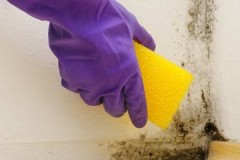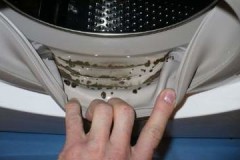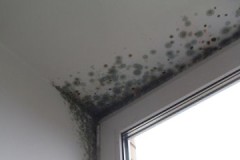Housewives on a note - how to remove mold from clothes at home
 A warm room, high air humidity, poor ventilation are three reasons why an unwanted guest can settle in a wardrobe with clothes - mold.
A warm room, high air humidity, poor ventilation are three reasons why an unwanted guest can settle in a wardrobe with clothes - mold.
A grayish coating on favorite things and a specific smell are unambiguous signs of a fungus.
Do not be upset and think that things are hopelessly ruined. There are many effective ways to get rid of mold on your clothes without damaging the fabric.
Content
Can you remove it using folk methods?
Before using special chemicals, you can try simple and affordable options for getting rid of things from the fungus:
- laundry soap (brown);
- lemon juice;
- turpentine;
- ammonia alcohol;
- hydrogen peroxide (peroxide).
The successful experience of many housewives has proven the effectiveness of these methods.
Laundry soap
In the fight against mold, the familiar nondescript piece of brown soap will help. It contains alkali, which has a detrimental effect on fungal spores.
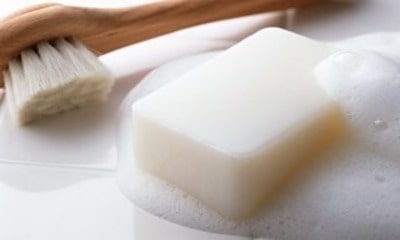 Four simple steps to achieve your goal:
Four simple steps to achieve your goal:
- dip the soap into warm water for a few seconds;
- rub it thoroughly on the part of the clothes soiled with mold;
- soak clothes in hot water for one hour;
- wash, dry in the air.
Lemon juice
Lemon can be found in the refrigerator of every housewife. In addition to its culinary uses, this fruit also comes in handy in saving clothes from mold.
Several manipulations will allow you to achieve the desired result:
- squeeze lemon juice onto a section of clothing infected with a fungus;
- sprinkle with salt and leave for fifteen minutes;
- remove the salt and send the thing to the wash;
- dry well.
Turpentine
A transparent liquid with a rich aroma, obtained from the resin of coniferous trees, has an anti-fungal effect.
For effective removal, you should:
- moisten a sponge with turpentine;
- gently rub the part of the clothing where the fungus is located;
- sprinkle this place with cosmetic white clay or baby powder;
- cover with a sheet of paper and iron with a hot iron for 2 minutes;
- remove the remains of clay (powder), wash the thing.
Ammonia
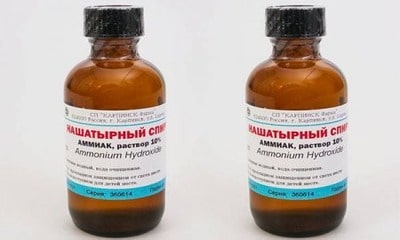 A ten percent aqueous solution of ammonia (ammonia) is a remedy that is useful not only for medical purposes, but also for removing mold.
A ten percent aqueous solution of ammonia (ammonia) is a remedy that is useful not only for medical purposes, but also for removing mold.
To successfully get rid of the fungus you need:
- dissolve one tablespoon of ammonia in a liter of water;
- moisten a cloth with fungus spots, leave for half an hour;
- wash and dry thoroughly.
Hydrogen peroxide
Peroxide (hydrogen peroxide) has a wide range of uses. It has also worked well as a remedy for removing fungal stains. Unlike chlorine-containing bleaches, peroxide is completely harmless to humans.
In the fight against mold, this solution is used as follows:
- Pour three tablespoons of 3% peroxide into a glass of water.
- Apply this solution to the desired parts of the clothing.
- Leave on for 15 minutes.
- Send the item to wash.
For even more information on folk remedies for fighting mold on clothes, see the video:
How to remove with chemicals?
If folk methods do not cope with mold colonies, household chemicals become a panacea.
Chemical agents are produced in the form:
- bleaches;
- washing powders;
- stain removers.
Bleaches
Bleaching agents are widely used not only for their main purpose, but also for removing fungal stains on clothes.
They are divided into:
- Oxygen-containing (ОХY, "BOS", Оxygen).
- Chlorine ("Whiteness", ACE, "Dichlor").
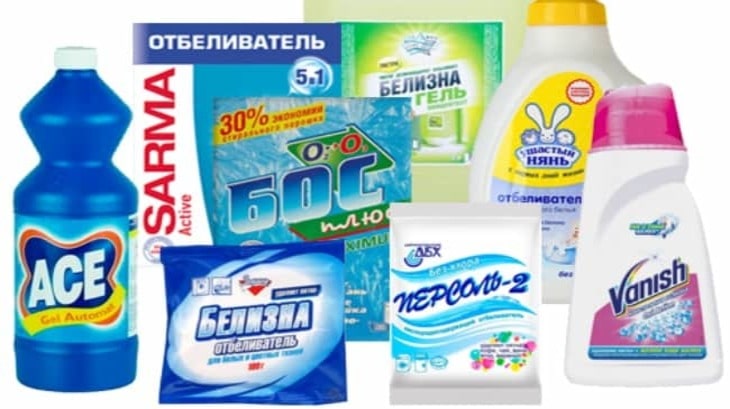
These products are used strictly in accordance with the instructions on the packaging.
Bleach containing oxygen has an antibacterial effect, work without prolonged soaking and boiling. They are used for both white and colored clothing. Works best with synthetic fabrics.
Chlorine bleaches are effective in removing mold stains even in cold water, but with frequent use, they have a negative effect on the structure of the fabric, leading to premature wear.
Used for white and dull linen and cotton fabrics. Only oxygen bleaches are used for machine washing!
Powders for washing
You can successfully treat the molds that have recently formed on clothes with laundry detergents:
- the dose of powder indicated in the instructions is added to hot water;
- clothes are dipped in a solution and kept for a couple of hours;
- then wash and rinse in an intensive mode.
Users highly appreciated the quality of washing powders such as:
- Ariel;
- Bimax;
- Tide.
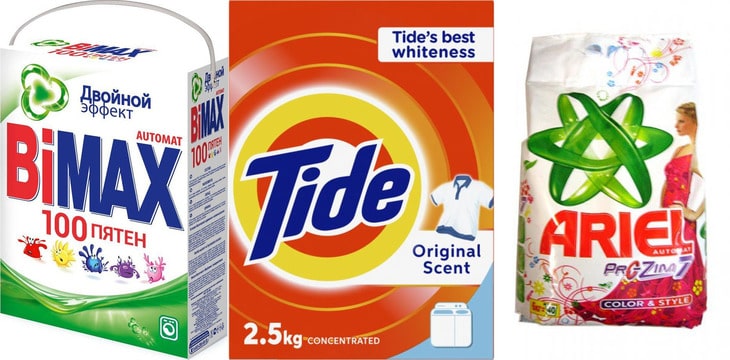
Stain removers
Stain removers easily remove fungus on fabrics. When buying, you should pay attention to what material this product is intended for.
Well proven:
- Dr. Beckmann;
- "Expert";
- "Antipyatin".
Procedure:
- apply to fabric;
- withstand a certain time;
- wash.
Popular remedies
The top three in terms of popularity include:
- "White";
- Domestos;
- Vanish.
"White"
The product of the chemical industry "White" successfully cleans large amounts of tissue affected by chronic fungus.
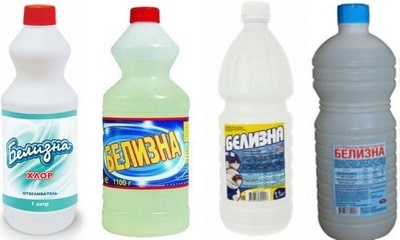 To do this, pour one tablespoon of this product into a glass of hot water and abundantly moisten the contaminated clothing surfaces.
To do this, pour one tablespoon of this product into a glass of hot water and abundantly moisten the contaminated clothing surfaces.
Twenty minutes is enough for a visible result. If the mold is difficult to remove, keeping in a solution of "Whiteness" of increased concentration is extended to a day.
To achieve the "sterility" effect, you can use boiling, taking into account the characteristics of the fabric.
The active ingredient of "Whiteness" is a strong oxidizing agent, which provides excellent disinfecting and bleaching properties.
The indisputable advantages of this tool are:
- Efficiency.
- Multifunctionality.
- Affordable cost (from 20 rubles per 1 liter).
There are also disadvantages:
- May cause allergic body reactions when used.
- Has a strong odor irritating the receptors.
"Domestos"
Domestos is a multifunctional product, perfect for cleaning and disinfecting the whole house. In addition, it can be used to expel fungus from natural materials (linen, cotton).
The procedure is as follows:
- dissolve two measuring caps of the product in three liters of room temperature water;
- put clothes there;
- stand for 10 minutes;
- rinse thoroughly;
- wash in a typewriter.
The advantages of Domestos include:
- profitability of spending;
- speed of performance;
- wide range of uses.
The cons are:
- Toxicity.
- Specific smell.
- Aggressive reactions to colored fabrics, stickers on clothes, appliques.
The average cost of the product is 170 rubles per 1 liter.
"Vanish"
Vanish's powerful oxygenated stain remover can be used safely to remove mildew from colored clothing in fine, delicate fabrics such as wool and silk.
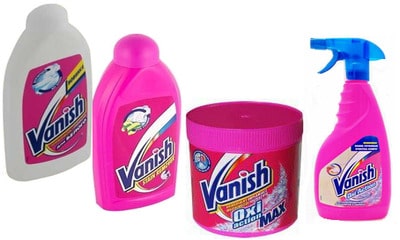 Mode of application:
Mode of application:
- Apply the stain remover to an area of clothing that is infected with the fungus.
- Rub the stain lightly, leave for a few minutes, visually controlling the process.
- Wash and dry well.
Vanish Features:
- Chlorine free.
- Affects mold without causing changes in the texture and color of the fabric.
- Has a pleasant smell.
Disadvantages:
- It cleans well only recently contaminated areas; old mold stains will have to be subjected to several treatments.
- The liquid version of the stain remover has a short shelf life, the effectiveness of the product decreases over time.
- The expected advertising effect does not always correspond to the actual one.
The line of the cost of Vanish stain removers starts from 400 rubles per 1 liter.
Criteria for the selection and use of funds
Choosing a product to kill mold on clothes you need to consider:
- Type of fabric.
- The color of the thing.
- The degree of infection.
- Processing method.
Cost also plays an important role.
Mold doesn't like high temperatures and chemicals. Tissues are also quite demanding on the methods and means of influencing them:
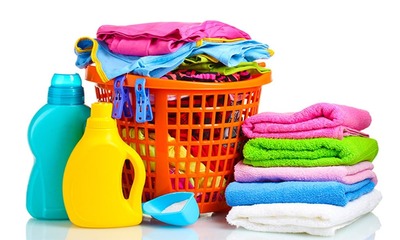 Linen and cotton clothes of white or pastel shades can be safely boiled with the addition of chlorine-containing products of the chemical industry.
Linen and cotton clothes of white or pastel shades can be safely boiled with the addition of chlorine-containing products of the chemical industry.- Woolen and synthetic fabrics react negatively to exposure to high temperatures, as this destroys their structure. To clean them from mold, stain removers are used.
- Silk items mold is best cleaned with turpentine or ammonia. Stain removers can damage delicate fabrics.
- Leather clothing not afraid of mechanical stress, but sensitive to chemicals, so it is better to remove mold from it with a stiff brush using a soapy solution.
- Bright things when exposed to chemicals, they can lose their color, therefore, before use, you should carefully study the rules for using the product and conduct a spot test of the reaction of the fabric on the wrong side of the clothing.
- Lightly contaminated fabric can be saved by the use of ordinary washing powder, but stain removers and bleaches will have to fight against a harmful substance firmly embedded in the structure of the material.
Fight odor
An invisible, but very annoying enemy - the specific smell of damp clothing.
To get rid of this amber, the following tools are useful:
- Vinegar 9% - dilute the washing powder with vinegar to a creamy consistency, then wash the clothes.
- Soda - add two to three tablespoons of it to the detergent when washing.
- Vodka - mix small amounts of vodka and water, spray on a cloth, dry well in the sun.
- Bura - after dissolving a tablespoon of the substance in water, add a little washing powder, leave clothes in this solution for a couple of hours. Then wash.
For more information see this article.
Prevention
You can reduce the risk of fungal stains on things by following these guidelines:
- Monitor the humidity of the room.
- Leave wardrobe doors open for ventilation frequently.
- Do not pile things up on hangers and shelves, provide air access.
- Dry clothes in direct sunlight.
- Place only dry items in the cupboard.
Conclusion
Compliance with preventive measures, timely response to the occurrence of mold and its prompt destruction are the key to the safety of clothes for a long time.

